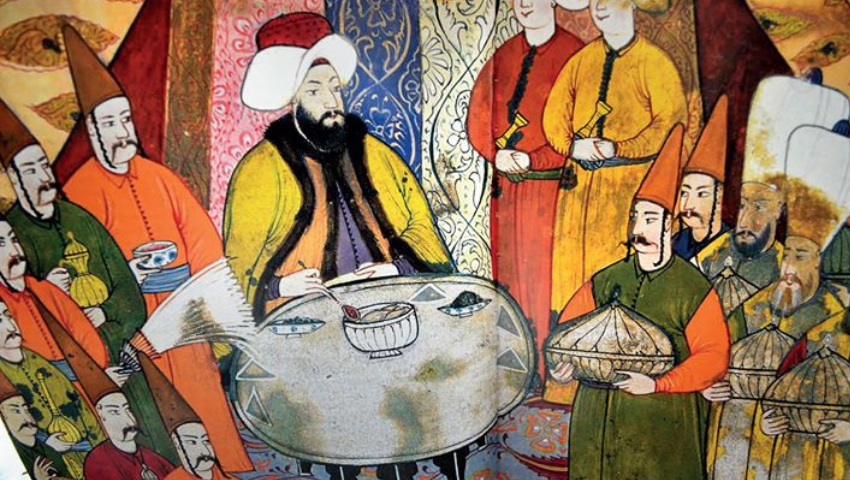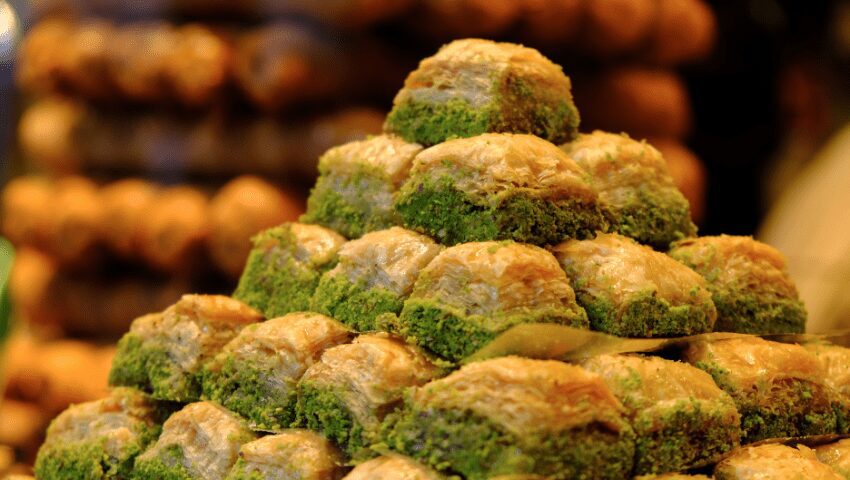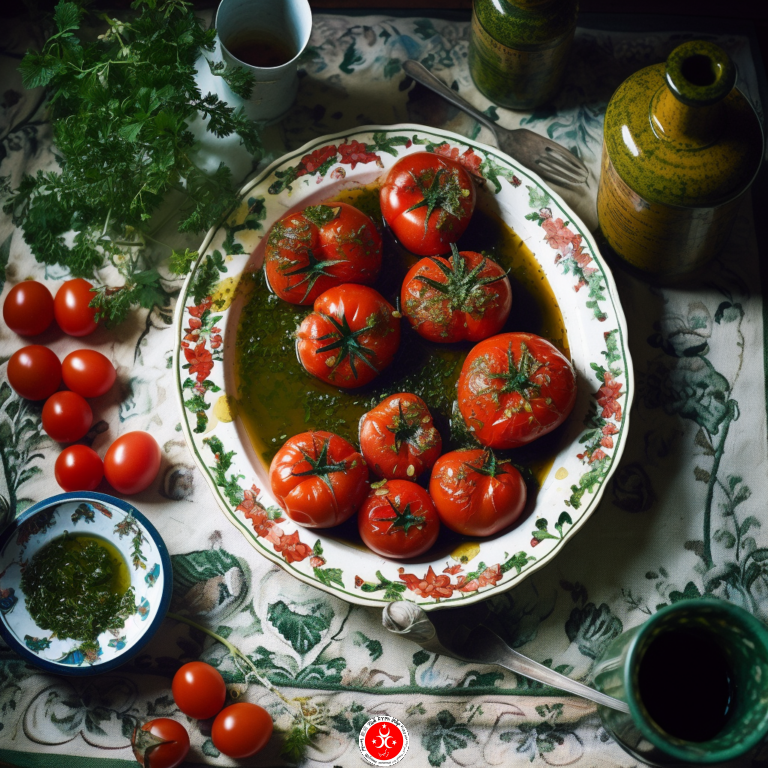Table of Contents
If you’re a foodie looking to expand your palate, you won’t be disappointed by Ottoman cuisine. A fusion of Middle Eastern, Mediterranean, and Balkan flavors, this cuisine encompasses a diverse array of dishes and spices that will leave your taste buds tingling.
In this article, we’ll explore the history and highlights of Ottoman cuisine, and give you a few dishes to try for yourself. Bon appétit!

Introduction to Ottoman Cuisine
Are you ready to discover the savory wonders of Ottoman Cuisine It is characterized by its diverse and unique flavors, resulting from the combination of Central Asian, Middle Eastern, and Mediterranean influences. The cuisine peaked during the Ottoman Palace era, where chefs created exquisite, complex dishes for the sultans and nobility. With special meaning associated with certain meals, every dish tells a story and is a reflection of the region’s culinary heritage. Explore the different sections of this blog to learn more about the staples of Ottoman Cuisine, including key ingredients, cooking techniques, and favorite dishes of the Sultan’s. Get ready to be transported to a world of taste and tradition.
Influence of Ottoman Cuisine to Other Cuisines
Ottoman cuisine has had a significant influence on other cuisines, particularly in the Middle East, Balkans, and Mediterranean regions. For example, Turkish kebabs have become a staple dish in many Middle Eastern and Mediterranean cuisines, and can be found in variations such as shish kebab, adana kebab, and kofta kebab.
Similarly, dolma, a dish of stuffed vegetables, has become a popular dish in Balkan and Middle Eastern cuisines, with variations such as Greek dolmades and Lebanese warak enab. Baklava, a sweet pastry made with layers of phyllo dough and honey, has also become a beloved dessert in many countries, including Greece, Armenia, and Iran.
Ottoman-style coffee has also become a staple in many Middle Eastern and Balkan cultures, and is often served alongside sweet treats such as Turkish delight. These dishes and ingredients are a testament to the enduring legacy of Ottoman cuisine and its impact on culinary practices around the world.
Turkish Customs and Traditions in Dining
When it comes to dining in Turkey, there are several customs and traditions that are still upheld today. Unlike some cultures where a quick meal on the go is typical, Turks prefer to sit down and enjoy their food.
They also take great pride in offering the best quality food and drink to their guests, often serving light snacks or pastries before the main course. This emphasis on hospitality and generosity is a hallmark of Turkish culture that extends to the dining experience. And with the country’s rich culinary history and diverse regional cuisines, there is always something new and exciting to try.
Food Diversity in Ottoman Cuisine
Now let’s talk about the food diversity in Ottoman cuisine! As we mentioned before, the Ottomans had a wide range of ingredient options due to the fertile lands of Anatolia and the multicultural structure of the empire. The result A cuisine that incorporated flavors and techniques from Central Asia, the Balkans, Caucasus, Middle East and Northern Africa.
From succulent meat dishes like kebabs and stews, to vegetarian options like pilafs and vegetable casseroles, the Ottoman cuisine has something delicious for everyone. And let’s not forget about the sweets! From sticky baklava to delicate Turkish delight, the desserts in Ottoman cuisine are truly a treat.
With such a diverse selection of dishes to choose from, it’s no wonder Turkish cuisine has become one of the world’s most popular. So, why not try something new and explore the rich flavors of Ottoman cuisine during your next meal
Main Courses in Ottoman Cuisine
You’ll find a wide variety of main dishes in Ottoman cuisine, from lamb and beef stews to grilled meats and rich casseroles. One of the most famous dishes is the çöp şiş, which features grilled lamb cubes that are marinated in spices and served on skewers with roasted vegetables.
Another popular dish is the hünkâr beğendi, a rich lamb stew that is served over a bed of creamy eggplant puree. And let’s not forget about the many pilaf dishes, which feature tender grains of rice cooked with meat and aromatic spices. No matter what main course you choose, you’re sure to be delighted by the rich flavors and intricate spices that are characteristic of Ottoman cuisine.
Desserts in Ottoman Cuisine

Desserts played a significant role in Ottoman cuisine, and the empire was known for its diverse array of sweet treats. Some of the most popular desserts in Ottoman cuisine included baklava, a flaky pastry filled with honey and nuts; Turkish delight, a chewy confection flavored with fruit and dusted with powdered sugar; and şekerpare, a soft and syrupy cookie made with semolina and almonds.
Other common desserts included halva, a sweet made from sesame paste and sugar, and lokum, a soft candy made from starch, sugar, and flavorings. These desserts were often served alongside tea or coffee and were an integral part of social gatherings and special occasions in Ottoman culture.
Also read: Gullac Recipe: A Traditional Turkish Dessert
Meals with Special Meaning in Ottoman
In Ottoman culture, special meals were prepared for various occasions such as funerals, weddings, and holidays. These meals were often prepared with great care and attention to detail, and were a reflection of the importance of hospitality and generosity in Ottoman society.
For example, funeral meals were typically prepared by the community and were a way of expressing sympathy and support for the family of the deceased. These meals often consisted of simple, comforting dishes such as soups, stews, and rice pilafs. Similarly, weddings were marked by elaborate feasts that included a variety of dishes such as kebabs, stews, and salads. These feasts were a way of celebrating the union of two families and were often multi-day affairs.
Finally, holidays such as Eid al-Fitr and Ashura were marked by special meals that included traditional dishes such as sweet pastries, stuffed vegetables, and wheat and legume dishes. These special meals were an important part of Ottoman culture and were a way of connecting with the traditions of the past while also celebrating the present.
Key Ingredients and Cooking Techniques
Now that you have a general understanding of Ottoman cuisine, let’s dive deeper into the key ingredients and cooking techniques that make it so distinctive. The foundation of most dishes consists of meat, vegetables, and legumes, which are typically cooked into a stew or soup.
Halva, a sweet confection made with flour or semolina, fat, sugar, milk, and cream, is a beloved dessert that satisfies any sweet tooth. Ottoman cuisine was also known for its use of spices such as saffron, cinnamon, and cumin, offering a fragrant and flavorful experience. As for cooking techniques, the use of the tandoor oven was prevalent, as well as the slow-cooking process, which allowed for maximum flavor and tenderness in meats.
By understanding the key ingredients and cooking techniques of Ottoman cuisine, you’ll be better equipped to create authentic and delicious Turkish dishes in your own kitchen.
Ottoman Palace Cuisine and its Importance
You’ve likely heard about Ottoman Palace Cuisine, and in this section, we’ll delve deeper into its importance. As we’ve discussed earlier, the palace cuisine can be considered the zenith of Ottoman culinary culture. It’s an essential part of understanding both Ottoman culture and Turkish cuisine since the basis of Turkish cuisine comes from this culinary tradition.
The palace cuisine was the most advanced and diverse cuisine in its time, and it set the standards for hundreds of years to come. The Sultan’s table bore an incredible wealth of hot and cold vegetable dishes, including beans and eggplants with its more than 40 varieties. And it wasn’t just limited to vegetables – the palace cuisine also offered an immense variety of meat dishes, sweets, milk and dairy products, pastries, and more.
The cuisine was so vast that hundreds of cooks specializing in different categories were involved in creating and preparing the dishes. With the combination of meticulous preparation and bold flavours, the palace cuisine became a symbol of power, wealth and prestige. Understanding the significance of the Ottoman Palace Cuisine gives us a richer appreciation of cultural history and culinary arts of the Ottoman Empire.
Favorite Dishes of Sultans
- Sultan Suleiman the Magnificent – Kebabs and Pilaf were among Suleiman’s favorite dishes. According to historical records, he was particularly fond of lamb kebabs and pilafs made with saffron, almonds, and raisins.
- Sultan Mehmed II – The conqueror of Constantinople was known for his love of Circassian Chicken, a dish made with shredded chicken, walnuts, and a tangy sour cream sauce.
- Sultan Abdulhamid II – One of the last sultans of the Ottoman Empire, Abdulhamid II was known for his love of traditional Ottoman cuisine. His favorite dishes included Börek, a savory pastry filled with cheese, meat, or vegetables, and Kebabs made with minced lamb.
- Sultan Selim III – Selim III was known for his love of Dolma, a dish made with stuffed vegetables such as peppers and eggplants. His favorite version was Dolma made with spiced rice, ground lamb, and herbs.
- Sultan Murad IV – The Ottoman sultan was a fan of sweet treats, including Baklava and Turkish Delight. According to historical records, he would often indulge in these sweet treats with his courtiers and advisors.
These dishes were among the many culinary delights enjoyed by the Ottoman sultans and were a reflection of the diverse and rich cuisine of the empire.
Specialization of Chefs in Ottoman Cuisine
If you’re a foodie, you’d know that Ottoman cuisine is celebrated worldwide for its distinct flavors and intricate cooking techniques. One fascinating fact about Ottoman cuisine is the specialization of chefs during the empire’s reign. Cooks specialized in particular areas of cooking, making dishes that were experts in their respective fields.
Here is a list of chefs you can often encounter in an Ottoman kitchen.
- Kebabçı – A chef who specializes in grilling meats, particularly lamb and chicken kebabs.
- Aşçı – A head chef who oversees the kitchen and manages the preparation of all dishes.
- Hamamcıbaşı – A chef who specializes in preparing soups, stews, and other slow-cooked dishes.
- Tandırcı – A chef who specializes in baking bread in a traditional oven called a tandır. Tandırcıs also use the oven to cook meat dishes such as lamb and chicken.
- Tatlıcı – A pastry chef who specializes in making sweets and desserts, such as Baklava, Turkish Delight, and Şekerpare.
- Pilavcı – A chef who specializes in making pilaf, a savory rice dish often served as a side to meat dishes.
- Dolmacı – A chef who specializes in making dolma, stuffed vegetables such as peppers, eggplants, and grape leaves filled with spiced rice, ground meat, and herbs.
These chefs played important roles in Ottoman cuisine, and their work was integral to the preparation of traditional dishes and the preservation of culinary traditions. They were often trained in traditional methods and techniques passed down through generations, and their work was highly valued by the Ottoman court and society.
Recipes and cooking tips for popular Turkish dishes
Now that we’ve explored the rich history and diversity of Ottoman cuisine, it’s time to get hands-on with some popular Turkish dishes. Here are some recipes and cooking tips to try at home:
For a classic kebab, marinate cubes of chicken or lamb in yogurt and spices like paprika, cumin, and oregano. Skewer and grill until cooked through, then serve with rice and salad.
For a vegetarian option, try making stuffed eggplant or “imam bayildi”. Cut slits in eggplants and fry until golden, then stuff with a mixture of onions, tomatoes, garlic, and parsley. Bake until tender and serve with crusty bread.
Baklava is a must-try dessert, with layers of flaky pastry filled with chopped nuts and sweet syrup. Make sure to brush each layer with plenty of melted butter before baking for maximum decadence.
When cooking Turkish cuisine, don’t be afraid to experiment with spices and herbs like sumac, mint, and Aleppo pepper. And don’t forget to serve your dishes with Turkish tea or strong coffee for a truly authentic experience. Happy cooking!






